

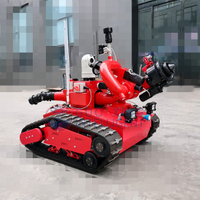
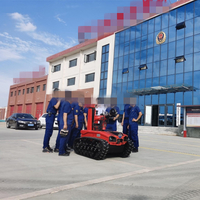
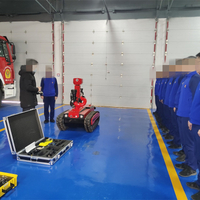

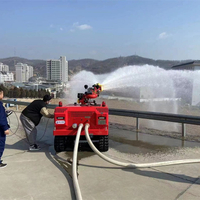

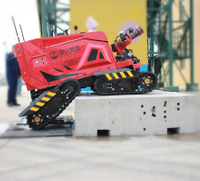
Understanding Explosion-Proof Standards: Differences Between ATEX and China’s GBIn industries such as petrochemicals, mining, firefighting, and hazardous chemical processing, explosion-proof equipment plays a vital role in ensuring safety. Globally, the European ATEX Directive and China’s GB standar
Tracked Robot Chassis Selection Guide: Load Capacity, Speed, and Endurance ExplainedIntroductionFor developers of industrial robots, firefighting robots, and unmanned ground vehicles, the tracked robot chassis is the foundation of performance. Choosing the right chassis directly impacts payload capa
RXR-M120D vs RXR-M150GD: Application Comparison of Heavy-Duty Firefighting RobotsIn high-risk environments such as petrochemical plants, power facilities, tunnels, and large warehouses, heavy-duty firefighting robots have become essential for modern emergency response. Guoxing’s RXR-M120D and RXR-M1
Discover the latest industrial firefighting robot trends in 2025, from AI-powered firefighting systems to explosion-proof firefighting robots designed for hazardous industrial zones.
Discover how Shandong Guoxing’s tank treads enable heavy equipment transportation with superior traction, stability, and load support. Explore their design, Christie suspension integration, and applications in construction, mining, and industrial logistics.
Firefighting has always been about one critical mission: protecting life, property, and assets from the destructive effects of fire. Over the years, the methods and technologies used to fight fires have evolved dramatically.
As fire disasters grow in complexity and risk, traditional firefighting methods increasingly face challenges in terms of safety, speed, and effectiveness. Enter the firefighting robot—a technological breakthrough designed to operate in environments too dangerous or inaccessible for human firefighters.
Firefighting has always been one of the most dangerous occupations in the world. In high-risk scenarios involving toxic smoke, collapsing structures, explosions, or limited visibility, firefighters put their lives on the line.
As fire disasters become more intense and unpredictable—particularly in industrial facilities, tunnels, chemical plants, and forested regions—there is a growing demand for advanced firefighting robots capable of surviving and operating in extreme conditions.
Industrial environments such as chemical plants, petroleum refineries and power stations represent some of the most hazardous fire zones imaginable. These areas are often filled with flammable substances, pressurized systems, volatile chemicals, and confined spaces—all of which pose a severe threat to both property and human life during a fire or explosion.
Fires can break out in a multitude of environments, and depending on the situation, they can become incredibly dangerous.
The growing demand for rapid, intelligent, and multifunctional fire response has made the firefighting robot a strategic asset in modern safety systems. As urban environments densify and industrial operations grow more complex, fire emergencies are no longer just about suppression—they also involve reconnaissance, hazardous material detection, and search and rescue.
Firefighting robots are advanced machines designed to assist human firefighters in combating fires, particularly in environments that are too dangerous or inaccessible for people. These robots play a crucial role in enhancing safety, efficiency, and effectiveness in fire suppression operations. They are equipped with sensors, cameras, and AI-driven systems that allow them to detect fires, navigate hazardous terrain, and deliver extinguishing agents with precision.
Firefighting robots are becoming an increasingly important part of modern emergency response strategies, offering a new way to address the challenges of fighting fires in dangerous environments. These machines are designed to assist or even take on tasks that would otherwise put human lives at risk, such as entering burning buildings, handling hazardous materials, or navigating areas with extreme heat and toxic smoke. As the technology behind robotics continues to advance, the role of firefighting robots is expanding rapidly, prompting discussions about their benefits, limitations, and the potential impact on the firefighting profession.
Firefighting robots have become one of the most innovative advancements in modern emergency response, offering safer and more efficient ways to combat dangerous fires. These machines are designed to operate in environments that would be life-threatening for human firefighters, handling high temperatures, toxic gases, and structural hazards without risking human lives.
Firefighting is one of the most dangerous and demanding professions, requiring courage, quick decision-making, and teamwork under extreme pressure. The emergence of advanced technologies such as artificial intelligence (AI) and firefighting robots has sparked discussions about whether machines could one day take over the role of human firefighters entirely. These innovations are already making a significant impact in detecting fires faster, improving safety, and enhancing firefighting efficiency.
Firefighting robots are becoming an increasingly important ally in protecting human lives and property from the destructive force of fire. These advanced machines combine cutting-edge engineering with artificial intelligence to handle dangerous firefighting tasks that put human firefighters at risk. They can enter burning buildings, navigate hazardous industrial zones, and operate in environments filled with toxic smoke—places where sending a human would mean certain danger.
In today’s rapidly evolving energy industry, intelligent automation has become one of the driving forces behind innovation and efficiency. Among the most impactful technologies reshaping the sector is the State Grid Robot.
Across industries, fire safety has evolved far beyond fire extinguishers and traditional response teams. In high-risk environments—factories, chemical plants, energy hubs, and underground facilities—safety demands smarter, faster, and safer solutions.
In recent years, global emergency response strategies have begun to shift toward automation and technology integration.